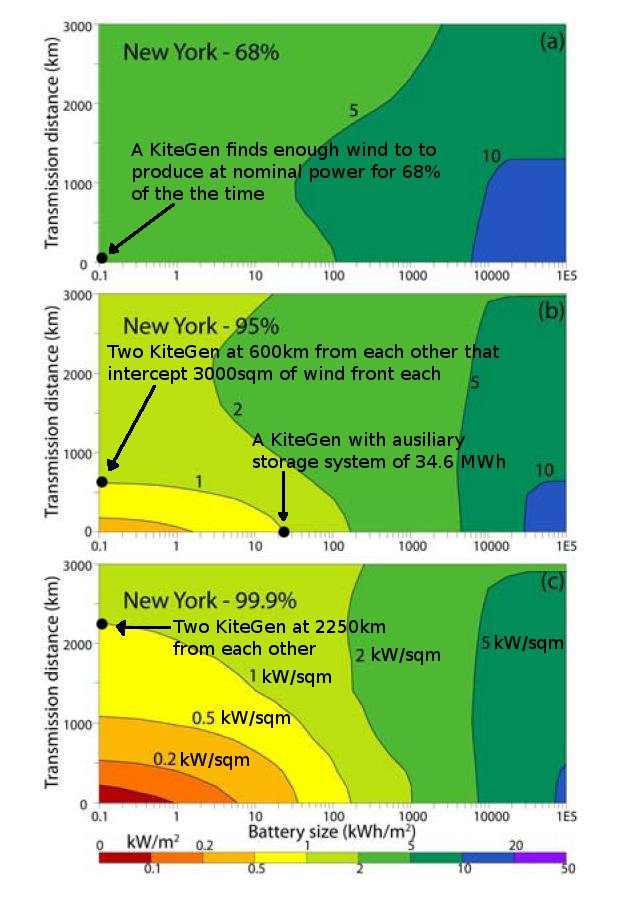ENERGY STORAGE UNDER KITEGEN PERSPECTIVE
 Originally written by Massimo Ippolito
Originally written by Massimo Ippolito
An insightful analysis, as always, by Domenico Coiante argues about renewable energy issues and the need for daily and seasonal storage.
It seems a good opportunity to introduce and clarify the opportunities offered in this area by the largest source of concentrated energy on the planet, the tropospheric wind.
The graph shown here comes from the methodology section of the “atlas of the winds of high altitude” of Cristina Archer and Ken Caldeira. It is a sophisticated representation which expresses a competitive or collaborative comparison between the possible accumulation of traditional systems, and the ‘opportunities to exploit the naturally stored energy in the geostrophic wind. Furthermore, it introduces “a trick” to get an annual availability of 99.9%, or 8751 hours a year guaranteed, far higher than any traditional source and nuclear power plants.
My suggestion is to devote sufficient time to decipher the original document, because the implications are of extreme importance. On this graph I added the indications referred to an example of KiteGen 3MW to make it easier to understand the logic. Note that the KiteGen Stem machines that fit in the example should be equipped with wings of 150 square meters with an equivalent aerodynamic efficiency of over 20.
The winds that envelop the planet can be seen as a huge “flywheel” of energy storage. The atmosphere has a total mass of 5 million billion tons, 5 * 10 ^ 18 kg, that flow with an average speed as to bring the total of 100,000 terawatt-hours of energy accumulated. To provide a comparison, this figure corresponds to the energy needs of the current activities of humans for over a year, but with the advantage that this massive accumulation is permanently restored by the photothermal solar dynamics.
While the photovoltaic panels must be deployed on the territory in order to minutely collect the energy supplied by the sun, KiteGen instead, is the PTO of this wide ” photovoltaic photomechanical panel” already naturally established and maintained by the atmosphere itself. This panel has collected energy in the kinetic form, which is a noble form, and it is therefore available for an efficient electrical conversion.
In a specific place, the example is referred to the New York area, the KiteGen generator can reach and pick up energy from this flow, with the probability of finding it powerful enough to produce power at rated power for 68% of the time, an equivalent already amazing of about 6000 hours per year. However, there is a limitation that does not depend on the flow of the wind fading but simply by the fact that it changes cyclically and erratically latitude.
So what is the idea that the diagram shows to push the tropospheric wind up to a 95% availability or even to a 99.9%? Simple enough, you need two generators located throughout the area at a distance sufficient to have at least one hit by the wind flow. The two generators are to be considered as a single system that will double the need for 68% of the time, but that will give a guarantee of delivery of the nominal value of one (of course this will cost twice as much).
In the chart, a comparison is made with equivalent and hypothetical electric storage systems, to achieve the same result of the two generators spaced.
If we assume a cost of electrochemical accumulation of 1 € / Wh, a point I have shown in the figure (b) it suggests 34.5 MWh. From this we get 34.5 million euro only for the storage batteries necessary for carrying out the service and bring availability to a 95%, cost in the order of magnitude of more than 10 times compared to the brilliant idea of having a spatial distribution of tropospheric generators.
What do we get from these reflections?:
1) The intermittent supply that plagues conventional wind and solar can be successfully overcome with the tropospheric wind; attributing the exclusive of the baseload on thermal plants is no longer correct.
2) The economic balance of this double facility can easily sustain the redundant generators as it can count on 68% + 68% + 32% of hours of availability, which would correspond to 11560 hours / year equivalent.
3) In case of advanced deployment and sufficient spatial distribution of KiteGen Stem farms, or KiteGen Carousel, these reflections will lose their special value, since the effect of redundancy is achieved inherently.
4) The redundancy would lead to have an excess of potential output, but the KiteGen are easily and quickly adjustable by means of a central coordination, providing a precise adaptation to the demand curve.
5) The excess energy due the redundant operative systems could be contractually provided at discounted rate to interruptible customers
6) The graph refers to the New York area, but the orographic influence that slow the winds fades as we go at higher altitudes, making it a good example for most of the globe.






